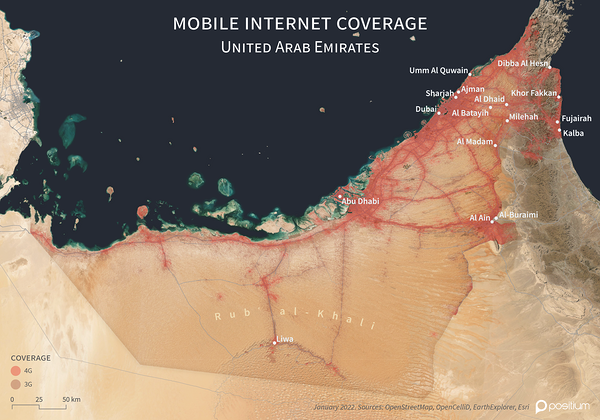For the past three years, Positium has taken part in the #30DayMapChallenge on Twitter. Last November, we went all in and created a map for all 30 challenge days. This had such an impact on us that we decided to have our very own map challenge, but at a bit calmer pace because, let’s be honest, #30DayMapChallenge is indeed quite a challenge. With that said, let us introduce the #2022MapChallenge, where we make one map every month to explore and explain the world of MPD and GIS.
In January, we focus on the United Arab Emirates, and with good reason. From 1 October 2021 until 31 March 2022, the UAE is hosting the Dubai 2020 Expo, which we have been happy to participate in as well. In January, Positium was part of the smart cities delegation from Estonia, led by the cities of Tartu and Tallinn. On 26 January, the United Nations Committee of Experts on Big Data and Data Science for Official Statistics (UN CEBD) launched five new handbooks on the use of mobile phone data for statistics.
Making this announcement in the UAE is quite fitting, if we take a look at some statistics about mobile phone and internet usage in this country. In 2020, there were remarkably 186 mobile-broadband subscriptions per 100 inhabitants. 99% of the population uses the internet, and a whopping 9.26 million people, which accounts for 93% of the total population, use mobile devices for internet access.
When we look at the data on mobile internet coverage in the UAE, it becomes clear that the coverage is quite uneven across the country. The coastal areas and North-East of the country are well covered with both 4G and 3G networks, while the Southern and Western parts remain mostly empty. This kind of uneven distribution of infrastructure can be explained by the varied geography of the UAE.
Rubʿ al-Khali, “Empty Quarter”, is a 650,000 km2 sand desert covering big parts of the Southern Arabian peninsula. While most of it is located in Saudi Arabia, it also reaches Oman, Yemen and the southern parts of the UAE, where it encompasses vast rolling golden and red sand dunes reaching as far as the eye can see.
For sustaining life, water is crucial. Among the seemingly endless sand dunes, two oases with substantial underground water can be found – Liwa in the South and Al-Buraimi in the East of Abu Dhabi. The Al-Buraimi oasis or Tawam, meaning “twins”, is located on the border of the UAE and Oman, where two twin settlements Al-Ain and Al-Buraimi can be found. The curved 100-kilometre arch of the Liwa oasis can be easily identified, as it has the southernmost settlements of the entire UAE. The belt of villages and also the highways connecting the oasis to Abu Dhabi can be easily spotted on the mobile network coverage map as well, as they clearly stand out like green date palm trees in the middle of an empty desert.
In today’s world, where being well connected is more important than ever, having mobile coverage and access to the internet is crucial for a well-functioning society. Mobile internet usage, in turn, produces vast amounts of data that can and should be used to improve societies and the quality of life through better-informed decisions. In the 21st century, the ability to analyse big data and take actions based on it, is like finding water in a desert that allows life to flourish.
Stay tuned for more maps throughout 2022 and make sure to spot them on our socials!
.png)

